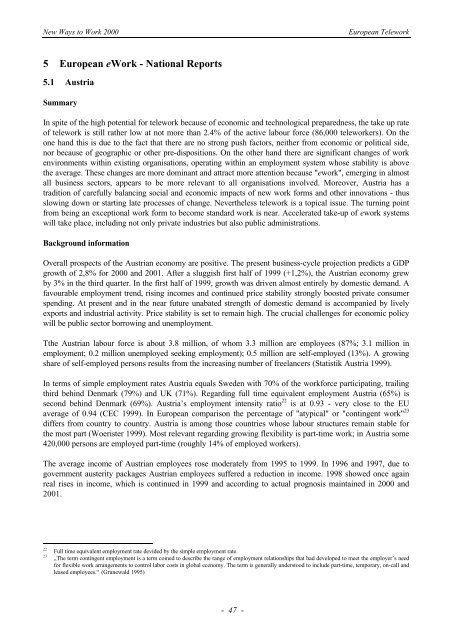eWORK 2000 - European Telework Week
eWORK 2000 - European Telework Week
eWORK 2000 - European Telework Week
- No tags were found...
You also want an ePaper? Increase the reach of your titles
YUMPU automatically turns print PDFs into web optimized ePapers that Google loves.
New Ways to Work <strong>2000</strong><strong>European</strong> <strong>Telework</strong>5 <strong>European</strong> eWork - National Reports5.1 AustriaSummaryIn spite of the high potential for telework because of economic and technological preparedness, the take up rateof telework is still rather low at not more than 2.4% of the active labour force (86,000 teleworkers). On theone hand this is due to the fact that there are no strong push factors, neither from economic or political side,nor because of geographic or other pre-dispositions. On the other hand there are significant changes of workenvironments within existing organisations, operating within an employment system whose stability is abovethe average. These changes are more dominant and attract more attention because "ework", emerging in almostall business sectors, appears to be more relevant to all organisations involved. Moreover, Austria has atradition of carefully balancing social and economic impacts of new work forms and other innovations - thusslowing down or starting late processes of change. Nevertheless telework is a topical issue. The turning pointfrom being an exceptional work form to become standard work is near. Accelerated take-up of ework systemswill take place, including not only private industries but also public administrations.Background informationOverall prospects of the Austrian economy are positive. The present business-cycle projection predicts a GDPgrowth of 2,8% for <strong>2000</strong> and 2001. After a sluggish first half of 1999 (+1,2%), the Austrian economy grewby 3% in the third quarter. In the first half of 1999, growth was driven almost entirely by domestic demand. Afavourable employment trend, rising incomes and continued price stability strongly boosted private consumerspending. At present and in the near future unabated strength of domestic demand is accompanied by livelyexports and industrial activity. Price stability is set to remain high. The crucial challenges for economic policywill be public sector borrowing and unemployment.Tthe Austrian labour force is about 3.8 million, of whom 3.3 million are employees (87%; 3.1 million inemployment; 0.2 million unemployed seeking employment); 0.5 million are self-employed (13%). A growingshare of self-employed persons results from the increasing number of freelancers (Statistik Austria 1999).In terms of simple employment rates Austria equals Sweden with 70% of the workforce participating, trailingthird behind Denmark (79%) and UK (71%). Regarding full time equivalent employment Austria (65%) issecond behind Denmark (69%). Austria’s employment intensity ratio 22 is at 0.93 - very close to the EUaverage of 0.94 (CEC 1999). In <strong>European</strong> comparison the percentage of "atypical" or "contingent work" 23differs from country to country. Austria is among those countries whose labour structures remain stable forthe most part (Woerister 1999). Most relevant regarding growing flexibility is part-time work; in Austria some420,000 persons are employed part-time (roughly 14% of employed workers).The average income of Austrian employees rose moderately from 1995 to 1999. In 1996 and 1997, due togovernment austerity packages Austrian employees suffered a reduction in income. 1998 showed once againreal rises in income, which is continued in 1999 and according to actual prognosis maintained in <strong>2000</strong> and2001.2223Full time equivalent employment rate devided by the simple employment rate.„The term contingent employment is a term coined to describe the range of employment relationships that had developed to meet the employer’s needfor flexible work arrangements to control labor costs in global ecenomy. The term is generally understood to include part-time, temporary, on-call andleased employees.“ (Grunewald 1995)- 47 -








